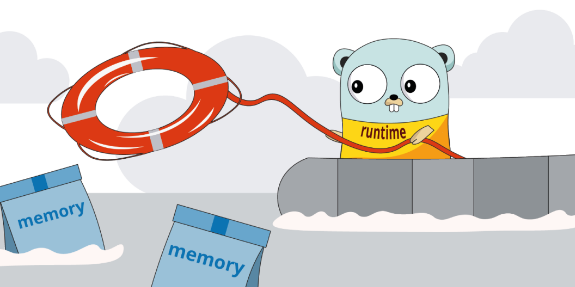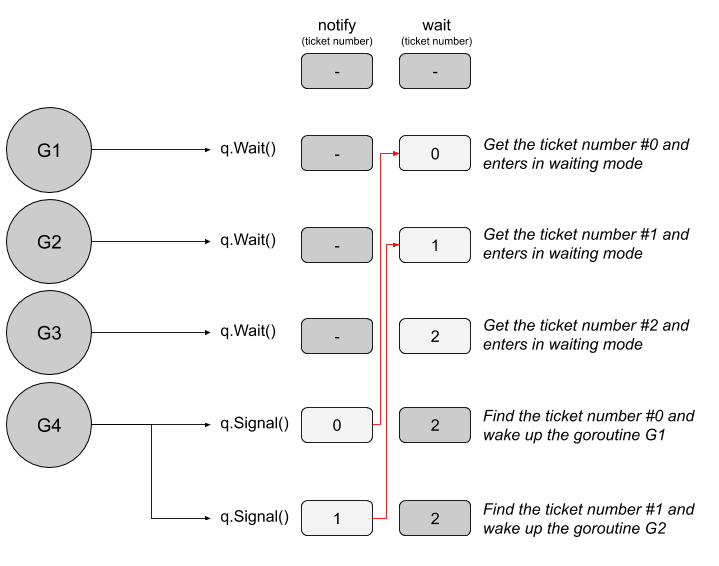Go监控模式(Monitor Pattern)

Go 能实现监控模式[1],归功于 sync 包和 sync.Cond 结构体。监控模式允许 goroutine 在进入睡眠模式前等待一个定特定条件,而不会阻塞执行或消耗资源。
条件变量
我们举个例子,来看看这个模式可以带来的好处。我将使用 Bryan Mills 的演示文稿[2]中提供的示例:
type Item = int type Queue struct {
items []Item
*sync.Cond
} func NewQueue() *Queue {
q := new(Queue)
q.Cond = sync.NewCond(&sync.Mutex{})
return q
} func (q *Queue) Put(item Item) {
q.L.Lock()
defer q.L.Unlock()
q.items = append(q.items, item)
q.Signal()
} func (q *Queue) GetMany(n int) []Item {
q.L.Lock()
defer q.L.Unlock()
for len(q.items) < n {
q.Wait()
}
items := q.items[:n:n]
q.items = q.items[n:]
return items
} func main() {
q := NewQueue()
var wg sync.WaitGroup
for n := 10; n > 0; n-- {
wg.Add(1)
go func(n int) {
items := q.GetMany(n)
fmt.Printf("%2d: %2d\n", n, items)
wg.Done()
}(n)
}
for i := 0; i < 100; i++ {
q.Put(i)
}
wg.Wait()
}
Queue 是一个非常简单的结体构,由一个切片和 sync.Cond 结构组成。然后,我们做两件事:
- 启动 10 个 goroutines,并将尝试一次消费 X 个元素。如果这些元素不够数目,那么 goroutine 将进去睡眠状态并等待被唤醒
- 主 goroutine 将用 100 个元素填入队列。每添加一个元素,它将唤醒一个等待消费的 goroutine。
程序的输出,
4: [31 32 33 34] 8: [10 11 12 13 14 15 16 17] 5: [35 36 37 38 39] 3: [ 7 8 9] 6: [40 41 42 43 44 45] 2: [18 19] 9: [46 47 48 49 50 51 52 53 54] 10: [21 22 23 24 25 26 27 28 29 30] 1: [20] 7: [ 0 1 2 3 4 5 6]
如果多次运行此程序,将获得不同的输出。我们可以看到,由于是按批次检索值的,每个 goroutine 获取的值是一个连续的序列。这一点对于理解 sync.Cond 与 channels 的差异很重要。
sync.Cond vs Channels
用单个 channel 解决这个问题并不容易,因为它会被消费者一个接一个地拉出来。
为了解决这个问题,Bryan Mills 编写了一个包含两个通道组合的等价解决方案(第 65 页)[3]:
type Item = int type waiter struct {
n int c chan []Item
} type state struct {
items []Item
wait []waiter
} type Queue struct {
s chan state
} func NewQueue() *Queue {
s := make(chan state, 1)
s <- state{}
return &Queue{s}
} func (q *Queue) Put(item Item) {
s := <-q.s
s.items = append(s.items, item)
for len(s.wait) > 0 {
w := s.wait[0]
if len(s.items) < w.n {
break }
w.c <- s.items[:w.n:w.n]
s.items = s.items[w.n:]
s.wait = s.wait[1:]
}
q.s <- s
} func (q *Queue) GetMany(n int) []Item {
s := <-q.s
if len(s.wait) == 0 && len(s.items) >= n {
items := s.items[:n:n]
s.items = s.items[n:]
q.s <- s
return items
}
c := make(chan []Item)
s.wait = append(s.wait, waiter{n, c})
q.s <- s
return <-c
}
结果类似:
1: [ 0] 10: [ 1 2 3 4 5 6 7 8 9 10] 5: [11 12 13 14 15] 8: [16 17 18 19 20 21 22 23] 6: [24 25 26 27 28 29] 3: [37 38 39] 7: [30 31 32 33 34 35 36] 9: [46 47 48 49 50 51 52 53 54] 2: [44 45] 4: [40 41 42 43]
在可读性和语义方面,条件变量在这里可能有一个小优势。但是,它也有限制。
注意事项
我们运行包含 100 个元素的基准测试,如示例所示:
WithCond-8 15.7µs ± 2% WithChan-8 19.4µs ± 1%
在这里使用条件变量要快一些。让我们试试 10k 个元素的基准测试:
WithCond-8 2.84ms ± 1% WithChan-8 917µs ± 1%
可以看到 channel 的速度要快得多。Bryan Mills 在“饥饿”部分(第 45 页)[4]中解释了这个问题:
假设我们调用 GetMany(3000) 的同时有一个调用者在密集的循环中执行 GetMany(3)。两个服务可能几乎同时醒来,但 GetMany(3) 调用将能够消耗三个元素,而 GetMany(3000) 将没有足够的元素就绪。队列将保持耗尽状态,较大的调用将一直阻塞。
该演示文稿还强调了在处理条件变量时我们可能面临的其他问题。如果模式看起来很简单,我们在使用它时应该小心。之前看到的例子向我们展示了如何更有效地使用 channel 并通过通信进行共享。
内部流程
内部实现非常简单,基于发号系统。以下是上一个示例的简单表示:

进入等待模式的每个 goroutine 将从变量 wait 开始分号,该变量从 0 开始。这表示等待队列。
然后,每次调用 Signal() 都会增加另一个名为 notify 的计数器,该计数器代表需要通知或唤醒的 goroutine 队列。
我们的 sync.Cond 结构包含一个负责发号的结构:
type notifyList struct {
wait uint32 notify uint32 lock uintptr head unsafe.Pointer
tail unsafe.Pointer
}
这是就是上面提到的 wait 和 notify 变量。该结构还通过 head 和 tail 保存等待的 goroutine 的链表,其中每个 goroutine 在其内部结构中保持对所获取的票号的引用。
当收到信号时,Go 会在链表上进行迭代,直到分配给被检查的 goroutine 的票号与notify 变量的编号匹配,如匹配则唤醒当前票号的 goroutine。一旦找到 goroutine,其状态将从等待模式变为可运行模式,然后在 Go 调度程序中处理。
- nagios被动监控模式
- 一段监控cli模式下运行php十分正常运行的shell脚本
- Zabbix Agent active批量调整客户端为主动模式监控
- Go Builder 建造者模式
- 使用Grafana监控Go应用
- Go---设计模式(策略模式)
- zabbix使用zabbix_java_gateway 监控java应用进程 主动模式 python脚本
- 【寒江雪】Go实现观察者模式
- php前端+go后端模式探索
- 使用GO语言开发 Redis数据监控程序
- Go 单例模式[个人翻译]
- GO实现文件夹监控
- CS模式短信监控系统的设计与实现 (转)
- Zabbix Agent active批量调整客户端为主动模式监控
- 集团监控平台前端解密之夜间模式
- Linux监控平台(主被动模式,添加监控主机,添加图形,处理图形乱码,远程执行命令)
- Go Facade外观(门面)设计模式
- 流模式的服务器监控页面
- Go --- 设计模式(模板模式)
- JDK5和JDK6对JMX的ObjectName模式支持的不同(监控应用服务器系列文章)
